Costs of War, by Heidi Garrett-Peltier
Costs of War
by Heidi Garrett-Peltier
Watson Institute International & Public Affairs, Brown University
February, 2015
NOTICE: THIS WORK MAY BE PROTECTED BY COPYRIGHT

Employment Impact
Military spending by the federal government is often considered a vital support to employment and economic recovery.
However, military spending creates fewer jobs than the same amount of money would have, if invested in other sectors. Clean energy and health care spending create 50 percent more jobs than the equivalent amount of spending on the military. Education spending creates more than twice as many jobs.
There are three reasons why this is the case. Industries such as education and clean energy are more labor-intensive. For a given level of spending, more of those dollars go toward hiring workers and less on equipment and materials. Also, a greater percentage of spending in education, health care, and clean energy construction stays within the US, creating more domestic jobs. Military personnel spend more of their earnings abroad and foreign contractors and employees get some portion of Pentagon spending. Finally, since wages and benefits are lower in those sectors than they are for military contractors and personnel on average, the same amount of money hires more people in those non-military sectors.
As a result, if over the years 2001-2014 the US had not been at war but instead had channeled resources into expanding the clean energy industry, broadening health care coverage, and increasing educational opportunities, between 1 and 3 million more jobs would have been created, reducing unemployment significantly.
Key Findings
• $1 billion in military spending creates approximately 11,200 jobs, compared with 26,700 in education, 16,800 in clean energy, and 17,200 in health care.
• The same amount of spending generates more jobs in certain non-military sectors because of differences in labor intensity, domestic investment, and wage levels.
Recommendations
• Congressional decision-making should foreground and use information about the job creation effects of military spending versus spending in other sectors.
(Page updated as of February 2015)
by Heidi Garrett-Peltier
Watson Institute International & Public Affairs, Brown University
February, 2015
NOTICE: THIS WORK MAY BE PROTECTED BY COPYRIGHT
YOU ARE REQUIRED TO READ THE COPYRIGHT NOTICE AT THIS LINK BEFORE YOU READ THE FOLLOWING WORK, THAT IS AVAILABLE SOLELY FOR PRIVATE STUDY, SCHOLARSHIP OR RESEARCH PURSUANT TO 17 U.S.C. SECTION 107 AND 108. IN THE EVENT THAT THE LIBRARY DETERMINES THAT UNLAWFUL COPYING OF THIS WORK HAS OCCURRED, THE LIBRARY HAS THE RIGHT TO BLOCK THE I.P. ADDRESS AT WHICH THE UNLAWFUL COPYING APPEARED TO HAVE OCCURRED. THANK YOU FOR RESPECTING THE RIGHTS OF COPYRIGHT OWNERS.

Employment Impact
Military spending by the federal government is often considered a vital support to employment and economic recovery.
However, military spending creates fewer jobs than the same amount of money would have, if invested in other sectors. Clean energy and health care spending create 50 percent more jobs than the equivalent amount of spending on the military. Education spending creates more than twice as many jobs.
There are three reasons why this is the case. Industries such as education and clean energy are more labor-intensive. For a given level of spending, more of those dollars go toward hiring workers and less on equipment and materials. Also, a greater percentage of spending in education, health care, and clean energy construction stays within the US, creating more domestic jobs. Military personnel spend more of their earnings abroad and foreign contractors and employees get some portion of Pentagon spending. Finally, since wages and benefits are lower in those sectors than they are for military contractors and personnel on average, the same amount of money hires more people in those non-military sectors.
As a result, if over the years 2001-2014 the US had not been at war but instead had channeled resources into expanding the clean energy industry, broadening health care coverage, and increasing educational opportunities, between 1 and 3 million more jobs would have been created, reducing unemployment significantly.
Key Findings
• $1 billion in military spending creates approximately 11,200 jobs, compared with 26,700 in education, 16,800 in clean energy, and 17,200 in health care.
• The same amount of spending generates more jobs in certain non-military sectors because of differences in labor intensity, domestic investment, and wage levels.
Recommendations
• Congressional decision-making should foreground and use information about the job creation effects of military spending versus spending in other sectors.
(Page updated as of February 2015)